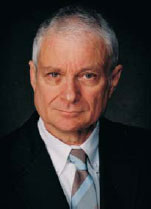 Sander Weinreb (Photo courtesy of Sander Weinreb)
Sander Weinreb (Photo courtesy of Sander Weinreb)
Sander Weinreb
Article contributed by Kenneth I. Kellermann
The 2008 Grote Reber Gold Medal for lifetime innovative contributions to radio astronomy has been awarded to Dr. Sander Weinreb of NASA's Jet Propulsion Laboratory and the California Institute of Technology. Dr. Weinreb is being honored for his pioneering developments of novel techniques and instrumentation over nearly half a century which have helped to define modern radio astronomy.
Weinreb received his PhD degree in electrical engineering from the Massachusetts Institute of Technology in 1963. While he was still a graduate student at MIT, he developed the world's first digital autocorrelation spectrometer which he then used to place a new upper limit to the Galactic deuterium to hydrogen ratio, and with Al Barrett, Lit Meeks, and J. C. Henry, he detected the OH ion, which was the first radio observation of an interstellar molecule. His autocorrelation spectrometer technique is now in use at virtually every major radio observatory throughout the world and has been crucial in the subsequent explosive growth of interstellar molecular spectroscopy.
In 1965 Weinreb came to NRAO where he became Head of the Electronics Division and later Assistant Director. During his 23 years at NRAO, he pioneered the use of low noise cryogenically cooled solid state amplifiers in radio astronomy. He was the architect for the electronic systems design for the NRAO Very Large Array in New Mexico and led the group which developed the novel front ends and the data transmission, acquisition, and monitor and control systems for the VLA.
Subsequently Sandy worked at first at Lockheed Martin Laboratories and then at the University of Massachusetts where he developed MMIC amplifiers and other millimeter wave devices. He has also been a Visiting Professor at the University of Virginia. Most recently he has been a Faculty Associate at Caltech and Principal Scientist at JPL where he has continued his work on MMIC devices and played a leading role in the electronics design for a new DSN space tracking array. He has been active in developing wideband feeds and front ends as well as investigating cost effective designs for modest size antennas, all of which will be important for the next generation of radio telescopes such the SKA. In addition he has been working with the Goldstone Apple Valley Radio Telescope (GAVRT) program to develop a 34 m radio telescope at Goldstone for use with schools around the globe.
The 2008 Reber Medal will be presented to Weinreb at the URSI Commission J business meeting to be held in Chicago on August 13. The Reber Medal was established by the Trustees of the Grote Reber Foundation to honor the achievements of Grote Reber and is administered by the Queen Victoria Museum in Launceston, Tasmania in cooperation with NRAO, the University of Tasmania, and the CSIRO Australia Telescope National Facility.
Modified on Wednesday, 02-Jun-2021 08:51:54 EDT by Ellen Bouton, Archivist (Questions or feedback)
|
![[IAU logo]](iau_wb_thumb.jpg)
![[URSI logo]](URSI-logo-thumb.jpg)
![[Karl Jansky at his antenna]](jansky_photo_02_thumb.jpg)
![[Reber's Wheaton antenna]](Reber_Telescope_Wheaton_thumb.jpg)
![[Dover Heights]](Dover_Heights_02_thumb.jpg)
![[4C telescope]](GB61-195_4C_telescope_thumb.jpg)
![[Ewen and horn antenna]](ewen_horn1s.jpg)
![[Dwingeloo, 1956]](Dwingeloo-1956-thumb.jpg)
![[Jocelyn Bell Burnell and Cambridge antenna used in pulsar discovery]](burnell2_thumb.jpg)
![[Lovell Telescope at Jodrell Bank]](site_1594_0001-500-334-20180316163019-thumb150.jpg)
![[Wilson, Penzias, and Bell Labs horn antenna]](wilson-penzias-horn_thumb.jpg)
![[6-m Millimeter Radio Telescope in Mitaka, Japan]](6m-thumb.jpg)

